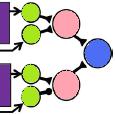Graeme Phillipson, 8th May 2008
Now that the projectors are mounted on a fixed frame they have less degrees of freedom to move relative to each other which simplifies the process of aligning them to each other. The degrees of freedom each projector has independently of the other one and the effect they have on the image are enumerated below.
| Degree of freedom | Effect on image, relative to other image. |
|---|
| Focus | Image is blurred.1 |
| Zoom | Image is larger or smaller at all points. |
| Lens shift | Image is vertically shifted. |
| Keystone | Image is compressed at one vertical extreme and expanded at the other. Vertical lines are not parallel. |
1 Image blurring may also be cause by the incorrect resolution setting, in which case the blurring will become better and worse across the screen with a regular period. It is also possible that the polarizing filters have heat damage, fingerprints or other defects so focus should be tested without the filters if it seems impossible to adjust correctly.
Since the rotations and translations of the projectors relative to each other are now fixed and we have seen that it is possible to get a good alignment if the alignment ever seems incorrect it is very unlikely that the errors will be best explained by these changes.
There are also several degrees of freedom that effect how both of the projectors produce an image on the screen which are enumerated below.
| Degree of freedom | Effect on image |
|---|---|
| Azimuth | Compressed at one horizontal extreme expanded at the other. Horizontal lines not parallel. |
| Elevation | Compressed at one vertical extreme expanded at the other. Vertical lines not parallel. |
| Torsion | Horizontal and vertical lines are parallel but not aligned with gravity. |
The most likely cause of future misalignments will probably be the azimuth of the stand if we believe no-one has adjusted the system recently. The reason for this is that this is the most easy to adjust by knocking the system or putting tension on the cables.



















